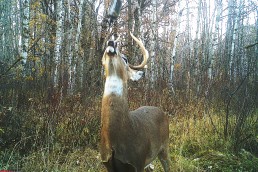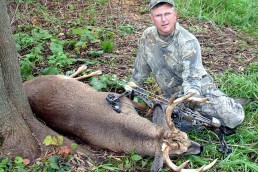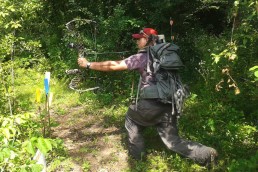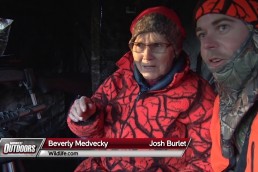Bowhunting Road
SHARE THIS POST
Like most serious whitetail hunters, I get excited when I see an area that’s all torn up with scrapes and rubs. It’s proof that a buck has been there recently, and in most cases, it takes a mature buck to do that much damage. My head starts looking upward at the surrounding trees, searching for one suitable enough for a treestand on the downwind side of the area. We would all like to think we could go out and find a spot like that and just hang a stand and shoot a buck the next time he comes along—if only it were that easy. The problem is the next time he comes through, it’s most likely going to be under the cover of darkness.
Several studies have shown that the vast majority of scrape visits by mature bucks are during the nighttime, especially in October, when the scrapes start to appear in numbers. My personal experience in monitoring hundreds of scrapes with game cameras would bear that out. But I have come up with a few tricks to turn the odds in my favor.
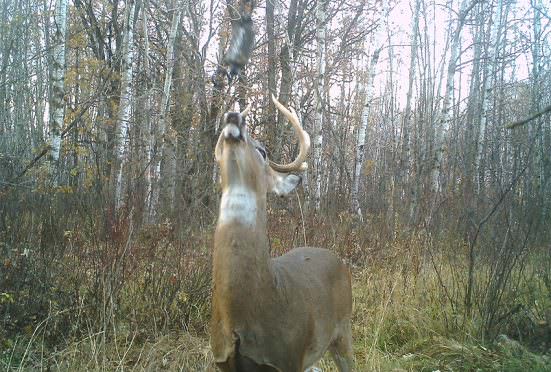
I have literally tens of thousands of photos of bucks and does at scrapes since I started using trail cameras to monitor and inventory deer where I hunt. Years ago, I first learned that scrapes were one of the best locations to get a feel for what is in the area. I travel to several states to bowhunt each year, and the first thing I’ll do is put cameras on scrapes to find out what I am dealing with as far as numbers of deer and numbers of nice bucks. I noticed that 80 to 90 percent of the scrape visits were at night, after legal shooting hours. That number improved slightly as the rut began in earnest during the first week in November but the odds were still low.
I began to wonder if there was anything I could do to activate the scrapes during the day—you know, get the bucks all worked up so they would visit the scrapes more often. I tried a few things that actually worked, and I have the daylight photos to prove it.
Here are some tactics for spicing up the scrapes and increasing the odds of getting bucks to the scrapes when in a treestand during legal shooting hours:
‘Fresh’ urine
The first thing I did was quite “offbeat,” but it really worked. I deposited some of my own fresh urine in a scrape. Don’t laugh—I’m dead serious. Most store-bought deer urine has an ammonia smell to it and doesn’t have the “fresh deer smell” that is expected near a scrape. After doing this for several years, I no longer feel weird standing over a scrape emptying my bladder. My urine is fresh and the deer are very curious about it. I have killed bucks over scrapes with my urine in them, and in one case, less than an hour after I put it there.
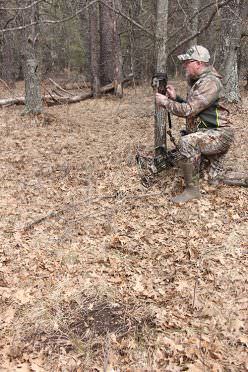
I freshen the scrapes with my urine each time I check the trail cameras, and I try to do it whenever I am hunting over a scrape. I no longer carry a “potty bottle” to the stand with me. If I feel the urge I’ll just climb down and anoint a scrape. If you have the guts to try this you will be convinced.
Import foreign dirt
Bucks and does alike know all the other deer in their home areas; they communicate throughout the year, mostly with scent. If a different deer moves into the area, they notice right away and focus some energy on learning it. I have found that I can use this tendency to activate a scrape. I carry a few clean zipper-seal bags with me at all times. When I come across a scrape, I often scoop a bag-full of the musty-smelling scrape dirt and take it with me. When I get back to the area I am hunting, I’ll dump the bag in a scrape near my treestand. Introducing this new scent to the area will arouse the curiosity and often the aggressiveness in the local bucks.
Are you enjoying this post?
You can be among the first to get the latest info on where to go, what to use and how to use it!
Use a Scrape Dripper
Wildlife Research Center makes a bottle that you can hang over your scrape called the Scrape Dripper. It has a rubber tube on the bottom that allows the lure from the bottle to drip slowly onto the scrape, continually adding fresh lure. Because of its design, it tends to drip more slowly when the weather is cold, so it adds more scent to the scrape during the daytime when it’s warmer.
I have used these quite a bit and I am convinced they do attract more deer to the scrapes. In an area with multiple scrapes, I often use Active Scrape Lure in one and a doe-in-heat lure in another. And yes, I have used my own fresh urine in these too. In fact, to save money I’ll fill the bottle half-full with commercial scent and top it off with my own. A 4-ounce bottle of lure in the dispenser will last about two weeks when it is really cold, and a few days when it’s warm.
Add a scrape and a rub
One of the best ways to enhance the area and attract attention is to add some scrapes and rubs to make it look like the area is a hub of deer activity. You can do this without introducing any foreign scent or deer lures, which can be an advantage if you are dealing with a particularly skittish buck.
I like to use a pocketknife and slice a few small trees or saplings down to the white inner bark, making it look like a fresh rub. I often use a knife to freshen existing rubs too. These visible indicators of a buck’s presence really get their attention. It might cause them to come over for a look, even when the scrapes alone wouldn’t have been enough.
I first introduced a scrape when I couldn’t find a tree in the exact spot I needed one for a treestand. So, I just added a scrape where I needed one. Seeing the bucks pay so much attention to this new scrape taught me their value. And I have since then been adding them to an existing scrape cluster. Choose a site under an overhanging branch and pull away all ground cover, exposing fresh dirt in an area about the size of a garbage can lid. I like to do it with a stout stick and throw the dirt back from the scrape as if it was built with aggression. Sometimes in grassy areas, you will need a rake to work up the sod.
Conclusion
There’s no need to be discouraged if all the bucks are hitting the scrapes in your area at night. These tips can help you activate the scrape clusters and bring out the aggression in the area bucks. Try a couple of these tactics this year and I’ll bet you agree that the bucks take notice, even during the day. At the very least you’ll be getting game camera photos of more bucks, and at the best, you will be in a photo holding one of them.
Bernie Barringer has hunted big game with a bow in more than a dozen states and in multiple Canadian provinces. Passion drives him to learn more and hunt new places, and this column is your ticket to his travels. The author of 13 books and thousands of articles, and appearing in videos, you can find even more from him at his website at bernieoutdoors.com, at bowhuntingroad.com and BowhuntingRoad on YouTube.
MWO
SHARE THIS POST
Did you enjoy this post?
You can be among the first to get the latest info on where to go, what to use and how to use it!
Bernie Barringer
Bernie Barringer has hunted big game with a bow in more than a dozen states and in multiple Canadian provinces. Passion drives him to learn more and hunt new places, and this column is your ticket to his travels. The author of 13 books and thousands of articles, you can find even more from him at bowhuntingroad.com and BowhuntingRoad on YouTube.
